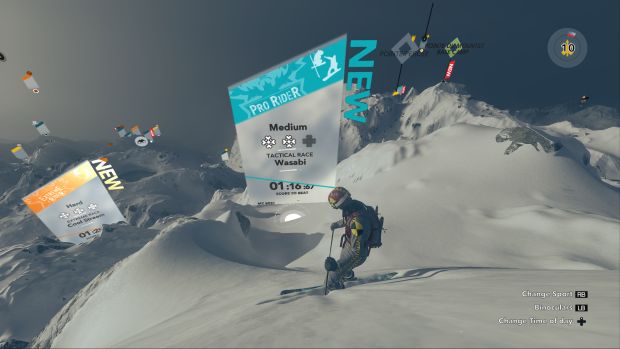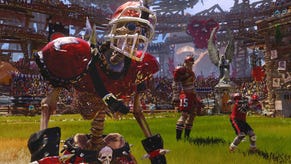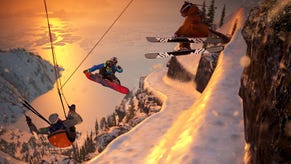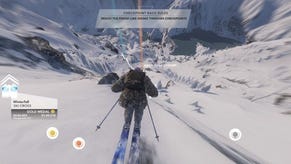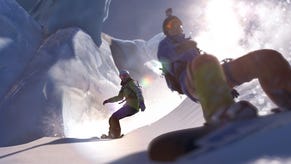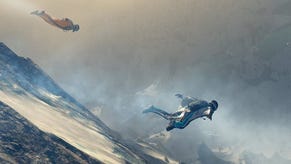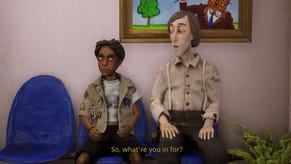Wot I Think: Steep
Hug that mountain
Steep [official site] is a lot like the extreme sportspeople it represents. It is excitable, loud and eager to have fun, fast and fresh. But in its haste and keenness it has somehow forgotten to take some of the most obvious precautions and frequently falls down flat on its face. The disappointing thing is that these failings – mostly failings of control and flow - haven’t just hobbled the game, they hobble the player too.
For snowboarding games, the pattern has generally been straightforward. Single-hit courses or tournaments for points or 1st place. Steep is trying something else, slathering Ubiconography over an open-world recreation of the Alps. In this, it is following the lead of SNOW, but adding a pair of binoculars that you use to spot and unlock distant ‘drop zones’. Whether the adaptation of the open world really works for this genre is another matter (it half works).
Mostly, you will be fast-travelling to new heights and barrelling downwards by one of three extreeeeeme methods - skis, snowboard, or wingsuit - which you can choose from a wheel at any time, so long as you are standing still and not in the middle of a race. There’s also paragliding, but more on that particular misjudgement later.
Events come in a few flavours, like straight races or freestyle tricksing. Others try to be wackier. One specific event sees you following a trail of flowers to a goat statue, another type forces you to follow an NPC rider, always much slower and less able than yourself, while you listen to the “story” of a particular mountain. These are dreadfully written monologues delivered by a voice actor personifying an Alp. “I am Monte Rosa,” says one mountain, sexily. “Roam free and seek out the secrets of my land.” “I am Peak of the Damned,” says another vast geological formation, “I am weak, tired and angry at man.” You should be, mate. Look at what they’ve done to you.
For the most part (thankfully) the events are just a push to get the most points, or a simple race to the finish line. There’s also the weirdly satisfying ‘bone collector’ events, which always involve a terrible and purposeful fall down the side of a ragged cliff face. It is impossible for your character to die.
You start cleaning up bronze, silver and gold quickly, leveling up and unlocking more courses and mountain summits while gaining cash for cosmetic gear – bobble hats, patterned wingsuits, trailing flares. I hit a plateau at about level 14 - a plateau of experience points, not a real one, with feelings. The only events I hadn’t completed were the paragliding ones. Next to the adrenaline-fueled snowboarding, super-fast wingsuit diving, and tree-dodging cross-country skiing, this lackadaisical parachute sport feels out of place, a sluggish contrast to everything else. In these events you go wobbling out into the air and must intuit air currents and checkpoints, navigating the atmosphere itself in a slightly faster way than your opponents. Of all the sports they could have thrown in as the desperate fourth spot on the extreeeeme wheel, why this one? Bobsledding would have made more sense. Ice fishing would have made more sense.
Cleaning up the icons began to become a slower process at this point, but you can always return to old bronzes in an attempt to better yourself. This wouldn't be a problem, except by this time Steep’s most bothersome quirks will have become clear.
I had already been subjected to the clunky controls in the beta, so I knew what to expect going back in. Still, after the fifth hour of flummoxed jumps and sudden halts, I found my teeth were grinding. There are a few problems with the controls and the stunt mechanics. The first is that the window to perform a jump is far too narrow. You see, to leap you have to hold down a trigger and release at a certain point, just before the end of a ramp. But this window is far too small and every small rise or natural bump has a different idea of where this “sweet spot” is.
The second problem is that both control sticks move your board/skis, but in different ways, both in the air and on the snow. This leads to all sorts of thumb gymnastics. For instance, to speed up you have to hold forward on the left stick (and you need this speed to do the jumps and stunts you want). But you also have to flick this stick (or the other stick (or both!)) in a certain direction after immediately releasing the R trigger (or L trigger (or both!)) all timed to this slim and changeable window, just before the ramp actually ends, no later and no sooner. But it doesn't end there. Now that you’re in the air, you should hold down the triggers again, that way you’ll grab your board or skis. Oh, and don't forget to let go of the sticks before you land. It’s an over-complicated system that tries hard to replicate the balance of skill, practice and intuition present in games like Skate or Olli Olli but ultimately fails to get that balance correct.
It is something you can improve with time and practice, but even after hours of gaining the ability to pull off ridiculous 1080 aerial corkscrews, I will still frequently fail to hit a ramp or bump correctly, whether because of a lack of speed, or because I moved my thumb from the acceleration too early, or because I missed the window, or because I moved a stick a millisecond too early, or because the ramp wasn’t as big as I thought, or as small as I thought, or or or… What I’m saying is that practice can help you out here, but it will only get you so far. Sometimes a control scheme is just plain janky.
This is Steep’s biggest offence. But sometimes it likes to be a jerk in other, smaller ways: suddenly making some checkpoints half their normal size at a moment's notice, for instance. Or not showing you where new checkpoints will appear with enough time. Sometimes your player model goes in front of a critical point of your downhill view, meaning you can’t see what you are speeding towards. In fact, the camera in general could be called “uncooperative” but that would imply it could be controlled even slightly. As it stands, while riding it does whatever it likes, trying to correct itself when no correction is needed, sometimes twisting itself into unholy almost-upside-down viewpoints where the only bodily response is to turn your own head in response and try to make sense of it all.
All this adds to Steep’s general problem, which is one of flow. Yes, when you fluff a course or a line, you can just hold ‘Y’ to restart the thing. And at first, this is a great addition, especially when you are learning how not to tumble into piles of jagged rocks. But later, it becomes just another frustration. You can barrel down a slope for ages and miss a single checkpoint, or get stuck behind the infuriatingly common fences, glitching out on the wood as you attempt to free yourself. Sometimes you just get stuck on a perfectly level glade of snow and your character forgets how to propel themselves forward, sliding around in every direction apart from the one direction you actually want to move in. Outside of a race, you can switch to walking and find a good spot to get moving again but during a race or event, you can't do this. Any of these irritating interruptions and it’s back to the top for you. On the harder routes you hit 'Y' again and again until it becomes too much and you exit out looking for a new route to calm your nerves.
In part, this is the trade-off for having an open world. A more traditional game might have slapped you back onto the course at a recent position (an imperfect design in itself) but in a giant realm like this I’m not sure if it’s technically possible to resort to that. Which brings into question the whole act of genre fusion here. Winter sports may simply be the type of game that doesn’t necessarily benefit from being transferred to an open world. What works in Burnout Paradise, where all roads can be traversed in any discernible direction thanks to, you know, motors, doesn’t work so well in an environment where you can only travel according to gravity. Fast travel and quick resets get you to the top of the course, but they don’t sweeten the bitterness of a checkpoint missed by an inch - sometimes only because the game decided to suddenly make it half the size of all the others.
It’s also buggy. I have found myself trapped inside cliffs, or frozen on the spot, as if the character model suddenly remembered how cold it was. My character often appeared standing on top of starting posts instead of beneath them, requiring a fiddly and annoying attempt to hop back down at each restart. None of these bugs are game-crushing but they do add to the overall sense of petulance and non-cooperation.
Half of Steep’s problems can be overcome with practice, the other half are frozen in place. Learn the land and the messy controls and you will have an OK time, and for a serious subset of fans and enthusiasts I imagine there is a lot to love about perfecting each and every line by sheer force of will or error. For me, the feeling of finally nailing that 10-part wingsuit ride is not so much rewarding as it is a grumpy relief.
There’s solace to be had in the environment, which is stunning (I’ve mentioned before that whoever is in charge of the snow effects deserves their own small award) and there’s some passing amusement to be gained from bringing up the automatic replay system and watching your character hit their head on some pylon cables in slow motion. But none of that can undo the testy controls and a dozen accompanying niggles. For all its enthusiasm, openness, and Red Bull product placement, Steep can’t overcome a mountain of small problems.
Steep is out now for Windows, via Steam.





